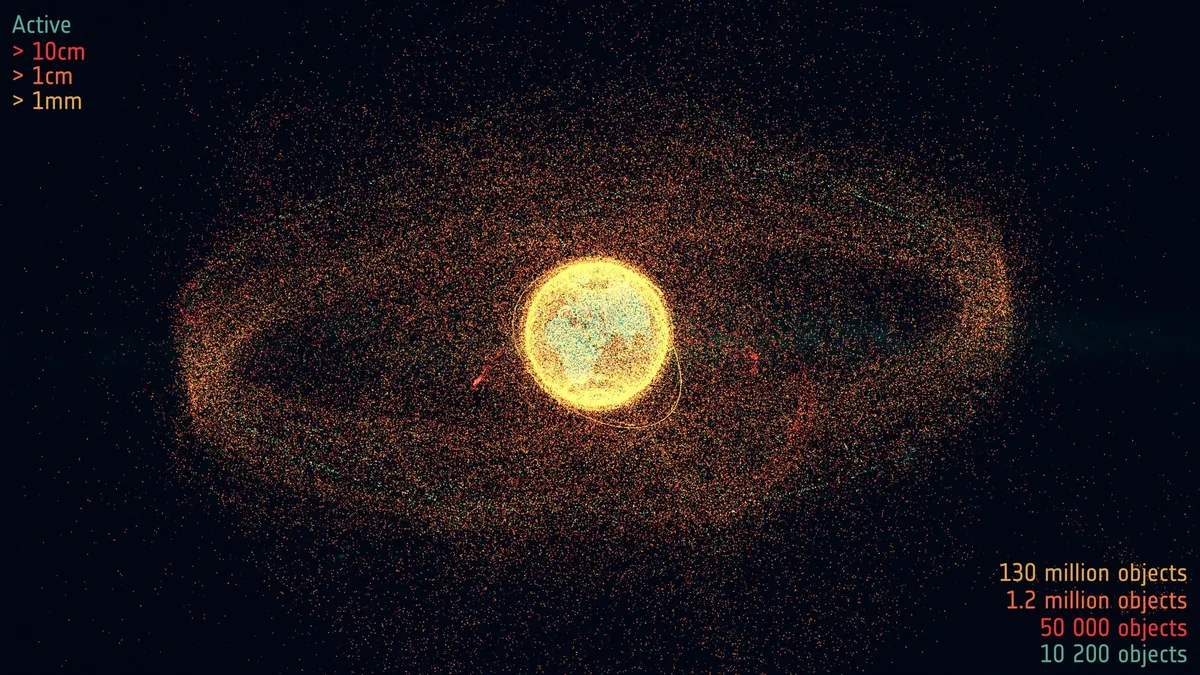
As we advance into 2025, our planet is encircled by a multitude of spacecraft that play a vital role in studying our changing climate, facilitating global communication and navigation services, and answering significant scientific questions. However, the orbits of these satellites are becoming increasingly congested with dangerous, fast-moving debris from defunct satellites and rockets, jeopardizing our future ventures in space. Since 2017, the European Space Agency (ESA) has published an annual Space Environment Report to provide a comprehensive overview of global space activities and assess the effectiveness of international debris-reduction measures aimed at promoting the long-term sustainability of spaceflight.
The 2025 report, which is based on data collected until the end of 2024, highlights several critical insights regarding the state of our Earth's orbital environment. One of the main takeaways is that Earth's orbital environment is a limited resource. Satellites that remain in their operational orbits after their missions are at risk of fragmenting into hazardous debris clouds that can persist in orbit for many years. The rise in the number and scale of commercial satellite constellations, particularly in low-Earth orbits, is alarming. In certain heavily populated altitude bands, the density of active satellites now rivals that of space debris.
Moreover, intact satellites and rocket bodies are re-entering the Earth's atmosphere more than three times daily on average. Unfortunately, a significant number of satellites do not leave these crowded orbits after their missions, further increasing the risk of collisions. The year 2024 saw numerous major fragmentation events, contributing thousands of new debris objects and emphasizing the urgent need for preventive measures such as passivation and reduced orbital lifetime strategies.
ESA's debris modeling tool, MASTER, indicates that the amount of space debris is escalating rapidly. Currently, about 40,000 objects are tracked by space surveillance networks, with approximately 11,000 classified as active payloads. However, the estimated count of debris objects larger than 1 cm—sufficiently large to cause catastrophic damage—exceeds 1.2 million, including over 50,000 objects larger than 10 cm.
In the realm of low-Earth orbit, the situation is becoming increasingly dire. The concentration of debris objects at altitudes around 550 km now poses a significant threat, comparable to that of active satellites. Notably, a substantial portion of active payloads in constellations is now operating at lower altitudes, with around 25% situated in the sub-500 km range.
The year 2024 experienced several major fragmentation events along with numerous smaller occurrences, resulting in an alarming increase of over 3,000 tracked debris objects. These fragmentation events underscore the necessity of implementing measures at the end of a satellite’s or launcher’s life that minimize the risk of such incidents. This includes employing passivation techniques to eliminate fuel and battery charges that could result in explosions and ensuring the safe removal of satellites from critical orbits.
On a positive note, the number of intact objects re-entering the Earth’s atmosphere in 2024 has shown an upward trend. The increase can be attributed to improved compliance with space debris mitigation guidelines, leading to the removal of satellites from important orbits at the end of their operational lives. Additionally, controlled re-entries of launchers outnumbered uncontrolled re-entries for the first time in 2024, reflecting a significant advancement in compliance efforts.
Despite improvements in mitigation efforts, the growth of space debris continues to outpace natural re-entries, resulting in a net increase in the space debris population. Scientific consensus indicates that even without additional launches, the number of space debris will keep rising due to fragmentation events that create new debris faster than existing debris can re-enter the atmosphere. This escalating situation risks triggering the Kessler syndrome, a chain reaction that could render certain orbits unsafe and unusable.
Looking ahead, the future of human spaceflight hinges not only on maintaining safe low-Earth orbits but also on preserving cislunar space—the region between Earth and the Moon. As we aim to explore beyond our planet, keeping lunar orbits free of debris is becoming increasingly critical.
The growing threat of space debris and the potential for Kessler syndrome necessitate the implementation of stricter global space debris mitigation practices. There is a burgeoning consensus among stakeholders in the space sector that adopting a 5-year limit for vacating busy orbits is essential for maintaining the viability of space activities.
To address the space debris challenge, ESA has set ambitious goals through its Zero Debris Approach, aiming to significantly limit debris production in Earth and lunar orbits by 2030. ESA is leading by example, updating its debris mitigation requirements, policies, and standards that govern mission design, construction, operation, and disposal. The agency has also facilitated the creation of the Zero Debris Charter, signed by 19 countries and over 150 commercial and non-commercial entities, emphasizing community-driven efforts to mitigate space debris.
To combat the rising threat of space debris, ESA is actively engaged in developing new technologies and capabilities aimed at debris prevention and removal. This includes advancing passivation techniques, preventing in-orbit breakups, and conducting missions like ClearSpace-1 for active debris removal. Even if no new debris is created, proactive measures are essential to prevent a cascade of collisions in our orbits.
As we strive to keep our orbital environment safe for future generations, it is imperative that we implement robust strategies for both debris mitigation and cleanup to ensure a sustainable future in space exploration.
For a comprehensive understanding, read the full ESA 2025 Annual Space Environment Report.